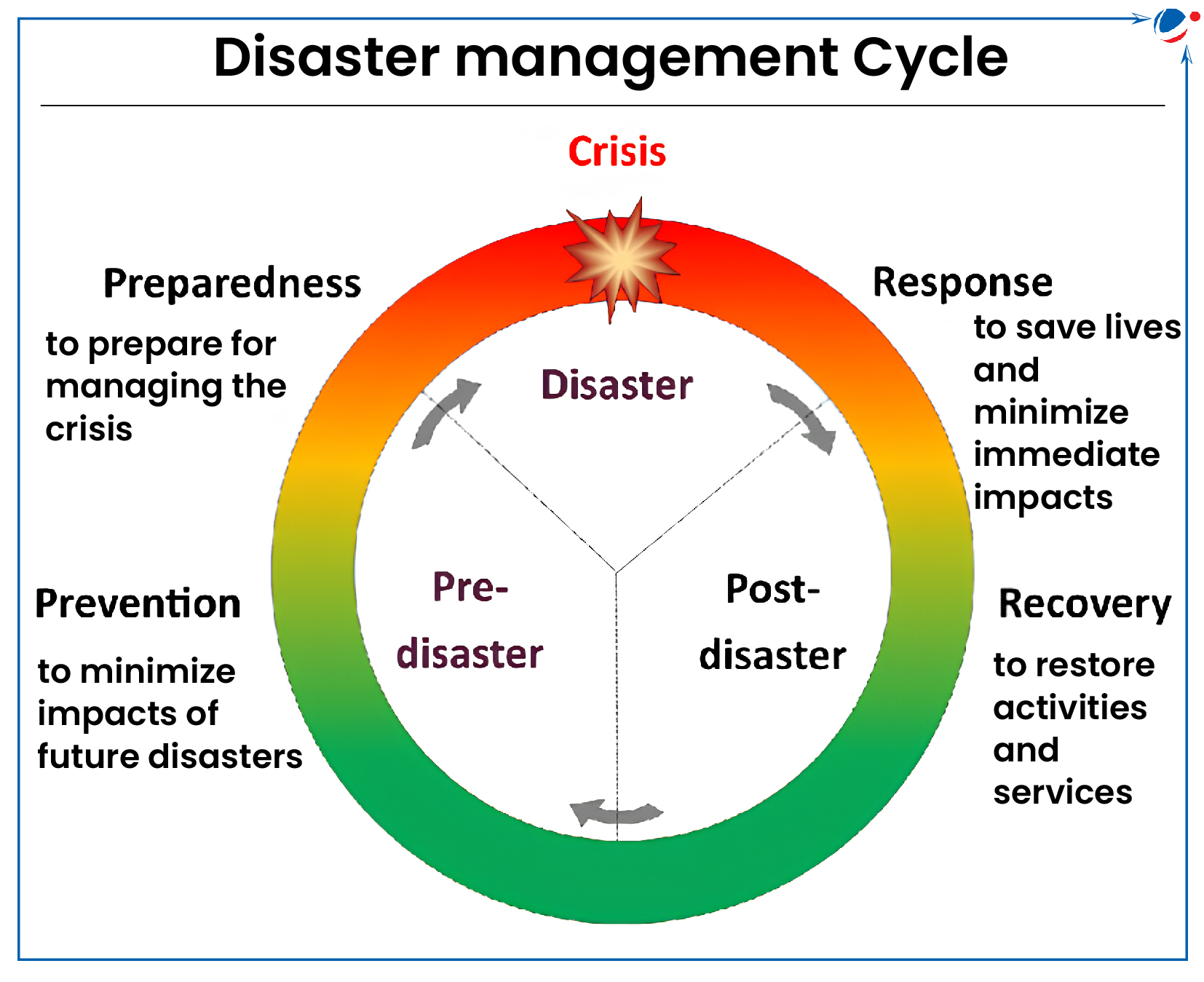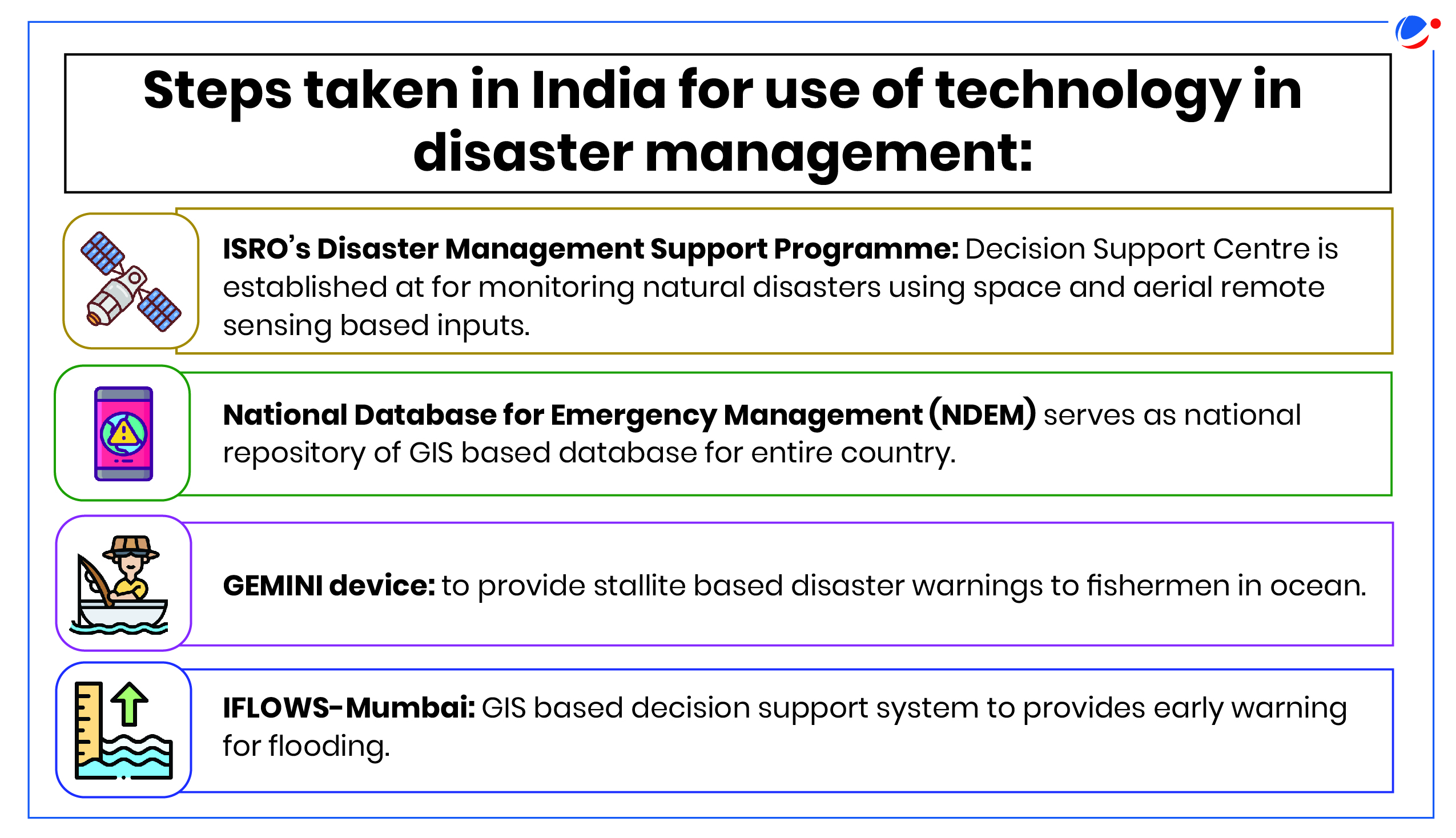Why in the news?
Recently, advancement in geospatial technology based on AI, Machine Learning (ML) and Internet of things (IoT) have been widely used in DMRR.

Use of Technology in Disaster Management Cycle:
It can be used at every stage of the cycle, from Prevention to preparedness to response to recovery.
- Prevention/Mitigation: Technology plays a crucial role in disaster mitigation by improving predictions and reducing risks. E.g., building hazard maps using AI.
- Preparedness: Technology can be used to help create and implement emergency plans. It can also be used to monitor potential threats, such as weather patterns that could lead to a natural disaster.
- Disaster prediction and early warning systems: Remote sensing, ML, drones can be used to collect and process data. AI is used for disaster modeling, usually through deep learning. E.g. Google Disaster Alerts
- Odisha State Disaster Mitigation Authority (OSDMA) has developed a web based platform called "SATARK" to provide warning information for various hazards such as heatwave, lightning, drought and flood monitoring.
- Event simulation: Objective is to prepare and train people. Key technologies for event simulation are Augmented Reality (AR) and Virtual Reality (VR). E.g. Mobile Learning Hub Philippines.
- Response: In an emergency, technology can be used to coordinate and manage the response effort. It can also be used to provide information and assistance to those affected by the disaster.
- Disaster detection: Social media platforms as an important source of information and means of communication during disasters. E.g. Earthquake detection through X(Formerly twitter).
- Emergency communication: AI powered chatbots can be powerful tools for managing and communicating with public during disasters. E.g., Covid-19 chatbots launched by WHO.
- Search and rescue: Identify people in critical need through satellite imagery or social media posts. E.g. Use of drones in Wayanad after landslide for search and rescue mission.
- Recovery: Technology can help with the rebuilding process after a disaster. It can be used to assess damage, create reconstruction plans, and coordinate relief efforts.
- Disaster relief logistic/resource allocation: 3D printing is being used to create unique components for machines, ensuring the functionality of critical systems during a disaster.
- Drones can be used to transport essential goods such as vaccinations or medical supplies.
- Disaster relief logistic/resource allocation: 3D printing is being used to create unique components for machines, ensuring the functionality of critical systems during a disaster.

Challenges with Implementation
- Technical limitations: It includes lack of technical knowledge & technical infrastructure and digital divide which can prevent the use of a technology.
- High cost: The cost of putting technologies like AI and drones into place and keeping them running can be high.
- Data requirements: Data is a critical enabler that determines the level of success. The key dimensions to consider in relation to data are access, quality, timeliness and relevance.
- Ensuring the quality of data is a challenge when it is used for real-time decision-making.
- Data responsibility and integrity: Responsible data use and collection, including privacy and integrity concerns, are critical because they can have a direct impact on the lives of vulnerable populations.
- Gender Dimension: Women's potentially limited access (or lack of access) to technology exacerbates concerns like data collection and crisis management.
Way Forward
- Private sector Participation: It can play an important role in bridging the technology gap and participating in technology-enabled disaster management.
- Bridging the Digital Divide and Enhancing Technical Capacity: Skill development for building technical knowledge, skills, and digital literacy of personnel involved in disaster management.
- Strengthening Community-Based Private Sector Networks: Further research and incentives can empower community-based private sector networks to support their communities more effectively during disasters, contributing to global resilience and preparedness.
Related News: Parametric Insurance
About Parametric Insurance
Advantages of parametric Insurance
|





